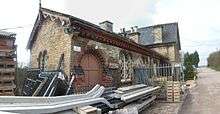Great Glen, Leicestershire
| Great Glen | |
 Great Glen |
|
| Population | 3,662 (2011) |
|---|---|
| OS grid reference | OSGB36 |
| Civil parish | Great Glen |
| Shire county | Leicestershire |
| Region | East Midlands |
| Country | England |
| Sovereign state | United Kingdom |
| Post town | Leicester |
| Postcode district | LE8 |
| Dialling code | 0116 |
| Police | Leicestershire |
| Fire | Leicestershire |
| Ambulance | East Midlands |
| EU Parliament | East Midlands |
| UK Parliament | Harborough |
|
|
Coordinates: 52°34′17″N 1°02′06″W / 52.57139°N 1.03499°W
Great Glen (or Glenn) is a village in Leicestershire, 2 miles south of Oadby on the outskirts of Leicester. The population of the civil parish at the 2011 census was 3,662.[1] Leicester City Centre is about seven miles north west. Its name comes from the original Iron Age settlers who used the Celtic word glennos meaning valley, and comes from the fact that Great Glen lies in part of the valley of the River Sence. The 'great' part is to distinguish the village from Glen Parva.
Features and amenities
In 1751 a turnpike bridge was built over the River Sence as a part of the stagecoach route from Leicester to London. The pubs The Pug & Greyhound (The Old Greyhound) and The Crown were originally coaching inns built soon after the new road opened. This road later became the A6 road, and a bypass around the village was opened in 2003. The Midland Main Line runs to the south of the A6, and formerly had a station to serve the village at the closest point.

Leicester Grammar School is constructed on the land of Mount Farm, Great Glen
There are two other schools in the village, the C of E St Cuthbert's primary school, which feeds to the local state schools in the neighbouring village of Kibworth and the town of Market Harborough. The independent school, The Stoneygate School, also has its site at Great Glen. Its pupils recently won Best Junior Choir at BBC Songs of Praise 2005 School Choirs Contest
There are now only three pubs surviving in the village - The Yews, The Royal Oak and The Greyhound.
The village park, The Recreation Ground on Bindleys Lane is the home of 2 of the villages sports clubs, Glen Villa FC and Great Glen Cricket Club.
At the centre of the village on the Stretton Road/Oaks Road T-junction is Great Glen Methodist Church, a Grade II* listed building. Built in 1827 it houses many activities including Sunday morning and evening services, a Sparklers mums and toddlers group on Mondays, Fusion children's group on Sunday mornings and Confusion alternate Friday evenings for teenagers. View the church at
The K6 Red telephone box on the village green is a listed building.
Trevor Benjamin used to live here and Engelbert Humperdinck has a home in the village.
The village is located at grid reference SP655975.
Stretton Hall
Stretton Hall was built in the 18th century, and though named after Stretton Magna it lies in Great Glen parish. Leicestershire and Rutland Joint Board for the Mentally Defective bought the hall in 1932 for conversion to a hospital. Under the NHS it was a residential hospital for learning disabled children and had 157 beds in 1979 . The hospital closed in the 1990s and a housing development has been built on part of the site.
History
Great Glen was the central place of an early Anglo-Saxon multiple estate.[2] The settlements that comprised this estate are: Great and Little Stretton, Wistow. Newton Harcourt, Fleckney, and Kilby. These parishes comprise the minimal extent of the estate which broadly follow the River Sence, the earlier name of which was Glen or Glennos, which was an earlier name of the river. It is possible that the estate extended further west along the river to Glen Parva where it joins the River Soar. It has not been possible to establish this securely. Glen (not Great Glen) enters the record for the first time in AD849 in an Anglo-Saxon royal charter.[3]
In the 16th century, Henry Grey, 1st Duke of Suffolk, father of the ill-fated Lady Jane Grey, became the lord of the manor. After his execution for treason, his lands were seized by the crown.
Following the Battle of Naseby in 1645, during the English Civil War, Great Glen played host to a band of Cromwellian soldiers who were pursuing some of the (defeated) Royalist Cavalry. They were later joined by the rest of the army who camped overnight before moving onto Leicester. Some of these soldiers made camp in the church where they caused much damage (such as breaking all the windows), of which some evidence can still be seen today. There are five road names in the village that mark these events: Cromwell Road, Naseby Way, Ruperts Way, Edgehill Close and Halford Close.
References
- ↑ "Civil Parish population 2011". Neighbourhood Statistics. Office for National Statistics. Retrieved 13 June 2016.
- ↑ Bourne, Jill (1996). Anglo-Saxons landscapes in the East Midlands. Leicestershire Museums Arts and Records Service.
- ↑ Anglo Saxon Charter 849 AD for aet Glenne>
External links
![]() Media related to Great Glen, Leicestershire at Wikimedia Commons
Media related to Great Glen, Leicestershire at Wikimedia Commons